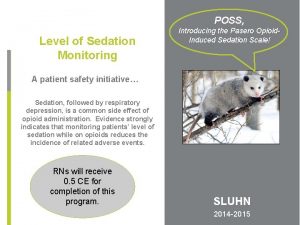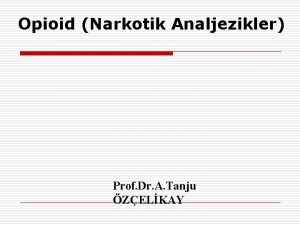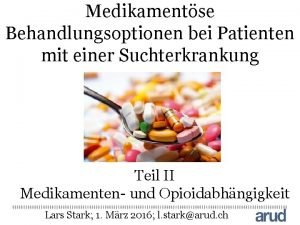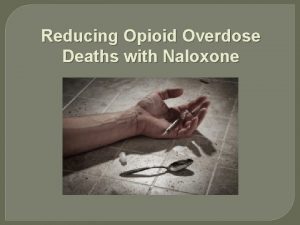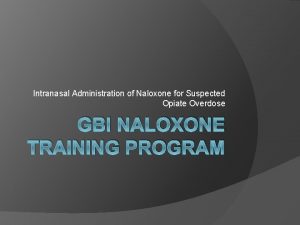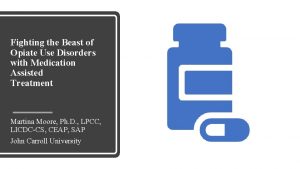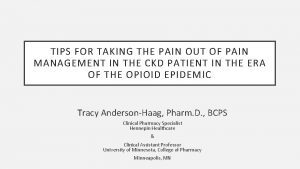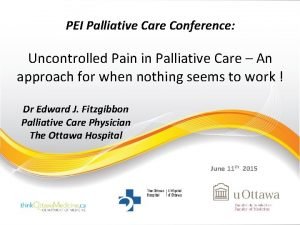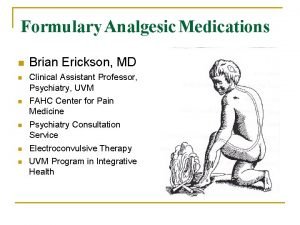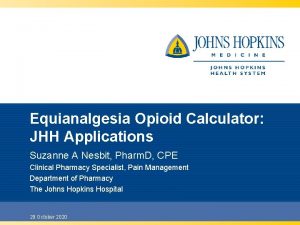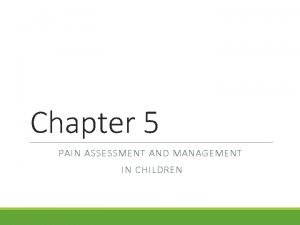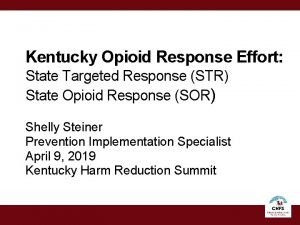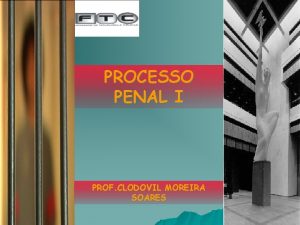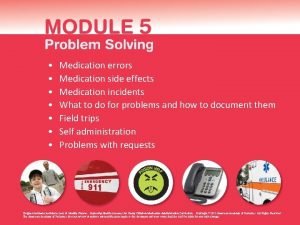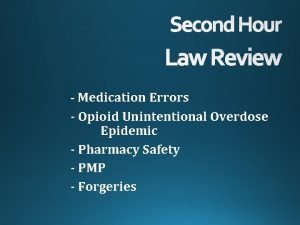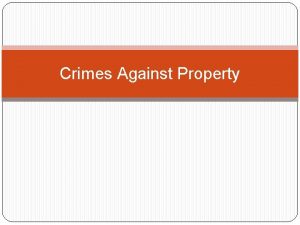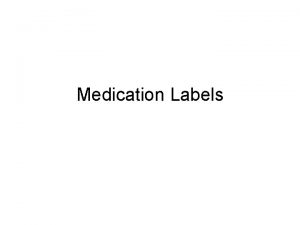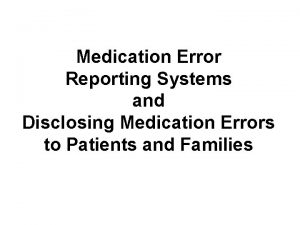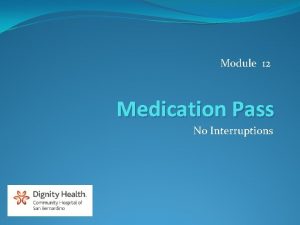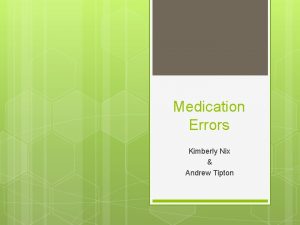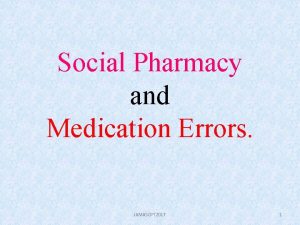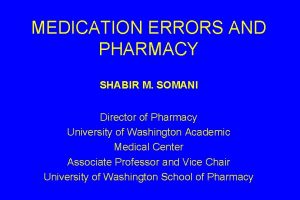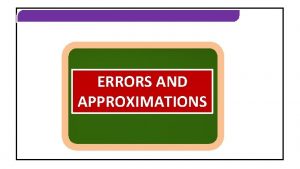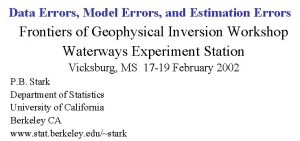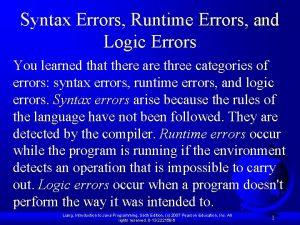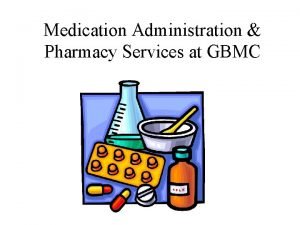Medication Errors Pharmacy Related Crimes and the Opioid























- Slides: 23

Medication Errors, Pharmacy. Related Crimes and the Opioid Overdose Epidemic Kris Mossberg, State Drug Inspector New Mexico Board of Phamacy

MEDICATION ERROR REPORTING • Critical in preventing future medication errors • Most Boards of Pharmacy require hospital & medical facilities (including pharmacies) to report med errors • NMBOP requires adverse drug event reporting

EVENT • Incident - a drug that is dispensed in error, that is administered and results in harm, injury or death • Harm - temporary or permanent impairment requiring intervention The Pharmacist in Charge shall: A. Develop and implement written error prevention procedures as part of the Policy and Procedures Manual. B. Report incidents, including relevant status updates, to the Board on Board approved forms within fifteen (15) days of discovery. • “Significant Adverse Drug Event Reporting Form” The Board shall: A. Maintain confidentiality of information relating to the reporter and the patient identifiers. B. Compile and publish, in the newsletter and on the Board web site, report information and prevention recommendations. Assure reports are used in a constructive and non-punitive manner. C.

MEDICATION ERRORS • BOP receives sworn Complaints Alleging Misfilled Prescriptions. • Not generated from Adverse Drug Event Reports. • Most of these would not have occurred if the pharmacist complied with BOP requirements for: • Prospective Drug Review • Counseling

Medication Error Reduction

Prospective drug review Prior to dispensing any prescription, a pharmacist shall review the patient profile for the purpose of identifying: (1) (a) (b) (c) (d) (e) (f) (g) (h) clinical abuse/misuse; therapeutic duplication; drug-disease contraindications; drug-drug interactions; incorrect drug dosage; incorrect duration of drug treatment; drug-allergy interactions; appropriate medication indication. Source: NMAC 16. 19. 4. 16 (D)

ONLY THE RPh CAN COUNSEL All clerks and technicians are taught that if there is a question regarding a prescription, the RPh (or intern) must take the question.

MEDICATION ERROR REDUCTION: PATIENT COUNSELING Patients need to know: Ø The name of the medication Ø How to take it Ø What it’s for Ø If the medication looks different, talk to the pharmacist http: //www. fda. gov/For. Consumers/Consumer. Updates/ucm 096403. htm accessed 6/3/16

PATIENT COUNSELING ØEstimate: half of medication-related deaths could have been prevented by appropriate and timely counseling. * ØShow the patient the drug while asking: 1) Tell me what you take this drug for? 2) Tell me how do you take the medication? -how often, and -directions for taking the medication

REMEMBER THE PATIENT • Patients provide a major safety check ØCounseling – not a “veiled offer” Ø Wrong patient errors: Not opening the bag at the point of sale Ø Risk of dispensing correctly filled Rx to wrong patient at POS – about 6 per month per (community) pharmacy

“To Err is Human” Building a Safer Health System • the majority of medical errors are caused by faulty systems, processes, and conditions that: • lead people to make mistakes • fail to prevent mistakes When an error occurs, blaming an individual does little to make the system safer and prevent someone else from committing the same

Safety Recommendation from NTSB • Remember to counsel on risk of impairment while operating a motor vehicle when dispensing any controlled substances for pain (or any CNS depressants like benzodiazepines, barbiturates, etc…). Safety Recommendations I-14 -1 and -2

When an error occurs • Be compassionate ØISMP persistent safety gaffe #4 respond with empathy and concern • Evaluate and address medication use system issues ØRoot cause analysis https: //www. ismp. org/newsletters/acutecare/showartic le. aspx? id=91

Root cause analysis (RCA): • Process for identifying the basic or causal factors that underlie variation in performance, including the occurrence or risk of occurrence of a sentinel event. • Focus is on systems and processes, not individual performance • Identifying root causes illuminates significant, underlying, fundamental conditions that increase the risk of adverse consequences. • RCA facilitates system evaluation, analysis of need for corrective action, tracking and

• Source: NM Board of Pharmacy newsletter March 2013

New England Compounding Center (NECC) – Framingham, Massachusetts • 753 patients were diagnosed with fungal meningitis after receiving injections of NECC’s preservative free MPA (methylprednisolone acetate). Out of 753 patients, 64 patients in nine states died • December 17, 2014 – United States attorney’s office charged owner and head pharmacist Barry J. Cadden, and Glenn A. Chin, a supervisory pharmacist, with 25 acts of second-degree murder in seven states • Twelve other individuals, all associated with NECC, were charged with additional crimes including racketeering, mail fraud, conspiracy, contempt, structuring, and violations of the Food, Drug and Cosmetic Act. (6 other pharmacists, 2 owners and 1 unlicensed technician) https: //www. justice. gov/usao-ma/pr/owner-new-england-compounding-center-sentenced-racketeeringleading-nationwide-fungal https: //www. cdc. gov/hai/outbreaks/clinicians/index. html https: //www. justice. gov/opa/pr/14 -indicted-connection-new-england-compounding-center-andnationwide-fungal-meningitis


Cadden directed and authorized the shipping of contaminated MPA to NECC customers nationwide - before test results confirming their sterility were returned, never notified customers of nonsterile results, and compounded drugs with expired ingredients. Cadden claimed to be dispensing drugs pursuant to valid, patient-specific prescriptions. In fact, NECC routinely dispensed drugs in bulk without valid prescriptions. NECC even used fictional and celebrity names on fake prescriptions to dispense drugs, such as “Michael Jackson, ” “Freddie Mae” and “Diana Ross. ” Chin improperly sterilized the MPA, failed to verify the sterilization process, and improperly tested it to ensure sterility. Despite knowing these deficiencies, Chin directed the MPA to be filled into thousands of vials and shipped to NECC customers nationwide. Chin directed the shipping of drugs prior to receiving test results confirming their sterility, and he directed NECC staff to mislabel drugs to conceal this practice. He also directed the compounding of drugs with expired ingredients, including chemotherapy drugs that had expired several years prior. Chin forged cleaning logs, and routinely ignored mold and bacteria found inside the clean rooms. https: //www. fda. gov/ICECI/Criminal. Investigations/ucm 594800. htm

Head Pharmacist – Barry Cadden • March 22, 2017 – Cadden convicted of racketeering, conspiracy, mail fraud and introduction of misbranded drugs into interstate commerce. Acquitted of murder charges. • June 26, 2017 - Cadden sentenced to 9 years in prison • https: //www. fda. gov/ICECI/Criminal. Investigations/ucm 564768. htm

Supervisor RPh – Glenn Chin October 25, 2017, Chin was convicted of racketeering, racketeering conspiracy, mail fraud and false labeling. Acquitted of 2 nd degree murder also. On January 31, 2018, Chin was sentenced to 8 years in prison, two years of supervised release, and forfeiture and restitution in an amount to be determined later. https: //www. fda. gov/ICECI/Criminal. Investigations/ucm 594800. htm

FDA Guidance – Insanitary Conditions • Putting on gowning apparel in a way that may cause the gowning apparel to become contaminated • Leaving the cleanroom and re-entering from a nonclassified area without first replacing gowning apparel • Performing aseptic manipulations outside of a certified ISO 5 area • Failing to disinfect containers of sterile drug components or supplies immediately prior to opening • Lack of adequate routine environmental monitoring nonviable airborne particulate sampling; viable airborne sampling; and surface sampling, including but not limited to equipment, work surfaces, and room surfaces

Insanitary Conditions - Continued • Lack of adequate personnel sampling (including glove fingertip sampling) • Lack of routine certification of the ISO 5 area, including smoke studies performed under dynamic conditions • Lack of HEPA-filtered air, or inadequate HEPA filter coverage or airflow, over the critical area • Buffer room or ISO 5 areas that contain overhangs or ledges capable of collecting dust (pipes and window sills) • Failing to appropriately and regularly clean and disinfect (or sterilize) equipment located in the ISO 5 area • Lack of disinfection of equipment and/or supplies at each transition from areas of lower quality air to areas of higher quality

Serious conditions - FDA recommendation includes immediate recall and cease sterile operations • Vermin (e. g. , insects, rodents) or other animals (e. g. , dogs) in ISO 5 areas or areas immediately accessible to production • Visible microbial growth (e. g. , bacteria, mold) in the ISO 5 area or in immediately adjacent areas • Sources of non-microbial contamination in the ISO 5 area (e. g. , rust, glass shavings, hairs, paint chips) • Performing aseptic manipulations outside of a certified ISO 5 area • Cleanroom areas with unsealed or loose ceiling tiles • Production of drugs while construction is underway in an adjacent area • Consistent and frequent pressure reversals from areas of less clean air to areas of higher cleanliness
 Two types of physical fitness
Two types of physical fitness Benefits of skill related fitness
Benefits of skill related fitness Poss score medical
Poss score medical Narkotik analjezikler
Narkotik analjezikler Ecotussin
Ecotussin Opioid overdose
Opioid overdose Opioid overdose
Opioid overdose Opioid overdose
Opioid overdose Non-opioid
Non-opioid Mechanism of action of opioid analgesics
Mechanism of action of opioid analgesics Children's pain scale
Children's pain scale Opioid receptors location
Opioid receptors location Brian erickson md
Brian erickson md Opioid settlement calculator
Opioid settlement calculator Non-opioid
Non-opioid Kentucky opioid response effort
Kentucky opioid response effort Puritan stocks punishment
Puritan stocks punishment How does sociology interpret hate crimes
How does sociology interpret hate crimes Crimes habituais
Crimes habituais O que é crime impossível
O que é crime impossível What are the crimes against public order?
What are the crimes against public order? What are the crimes against public order?
What are the crimes against public order? Street law chapter 9 crimes against the person
Street law chapter 9 crimes against the person How does ultranationalism lead to crimes against humanity
How does ultranationalism lead to crimes against humanity


